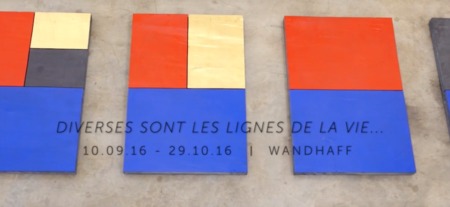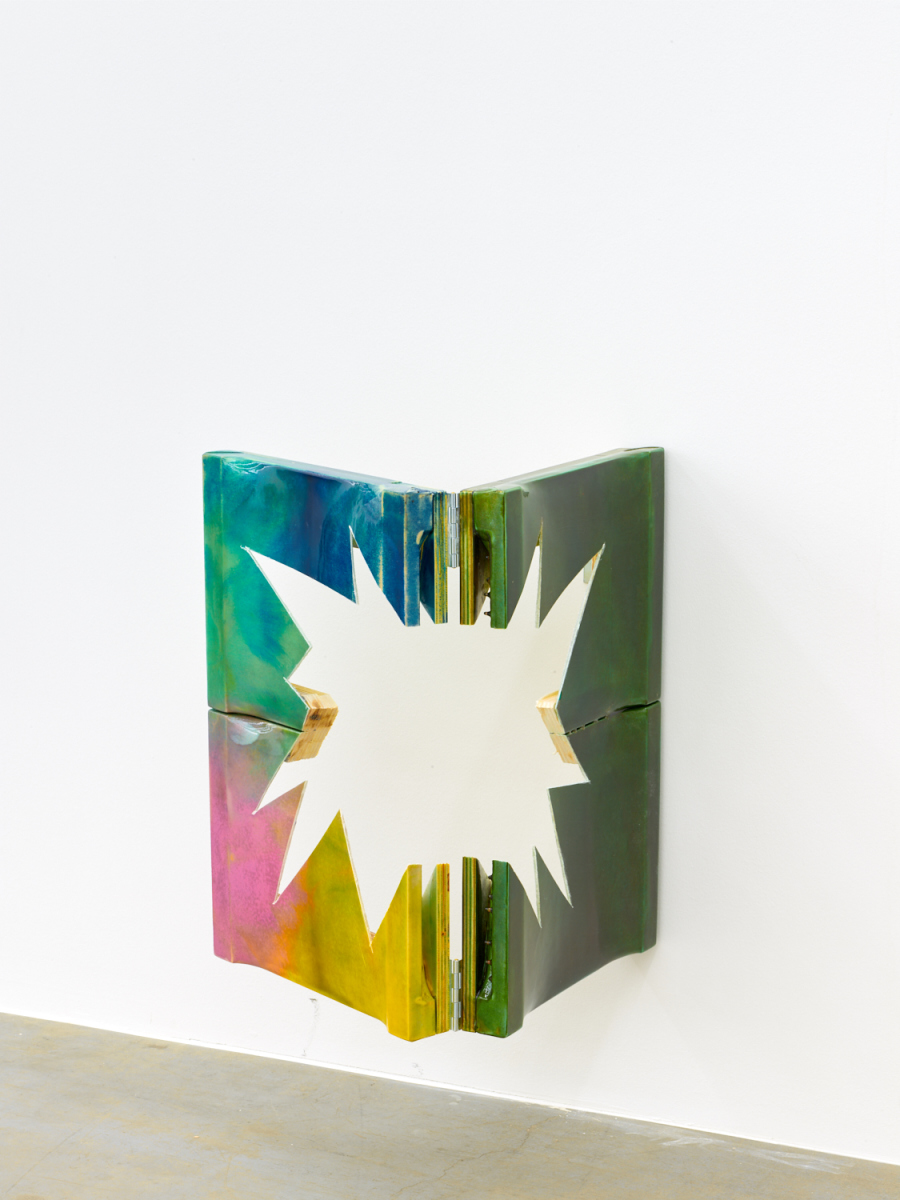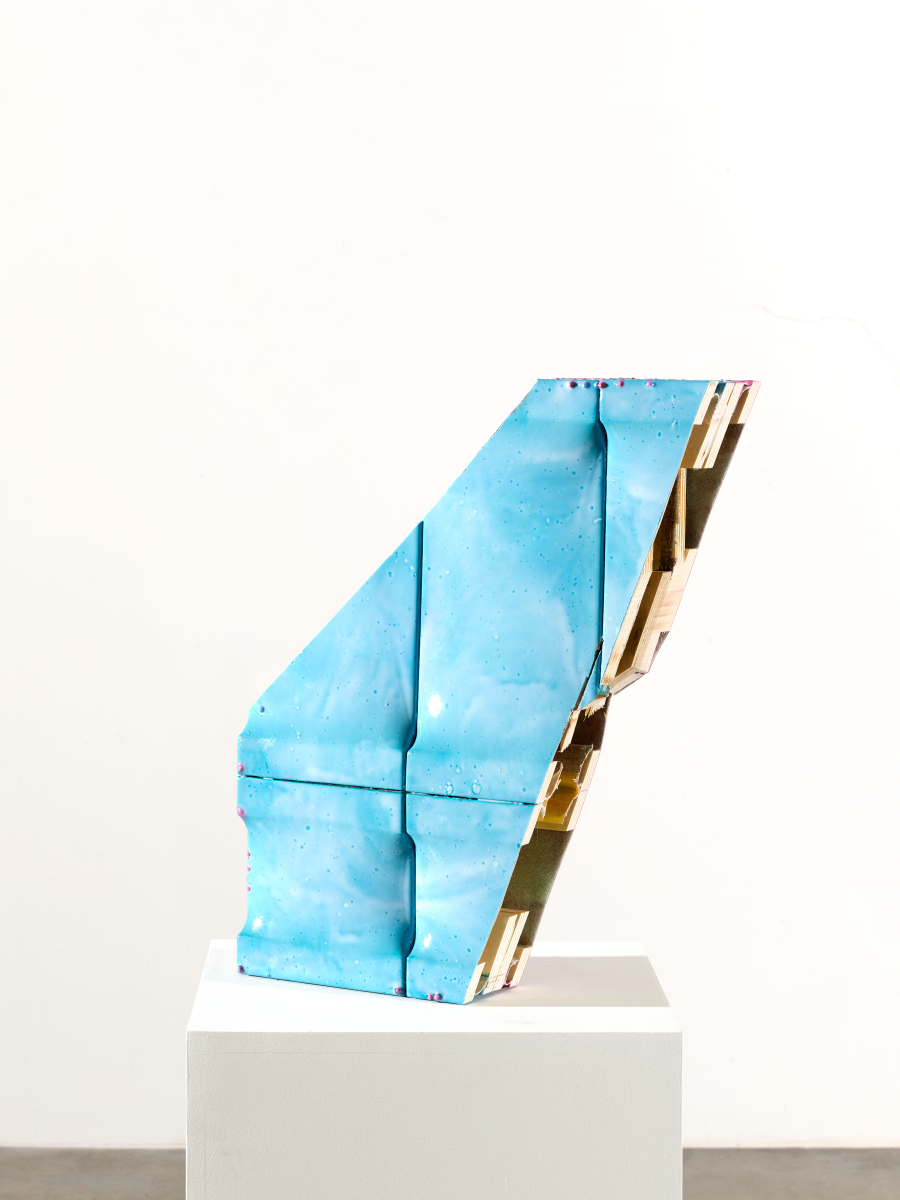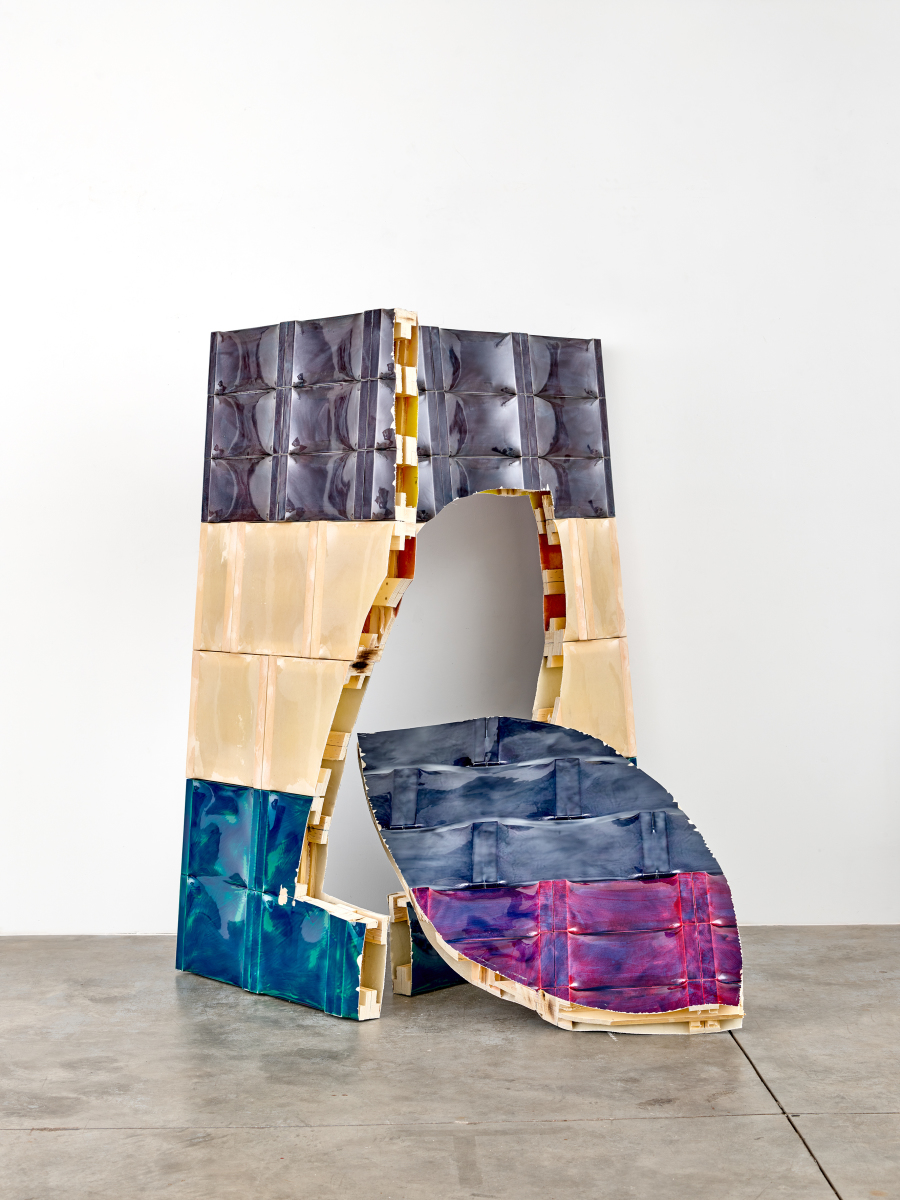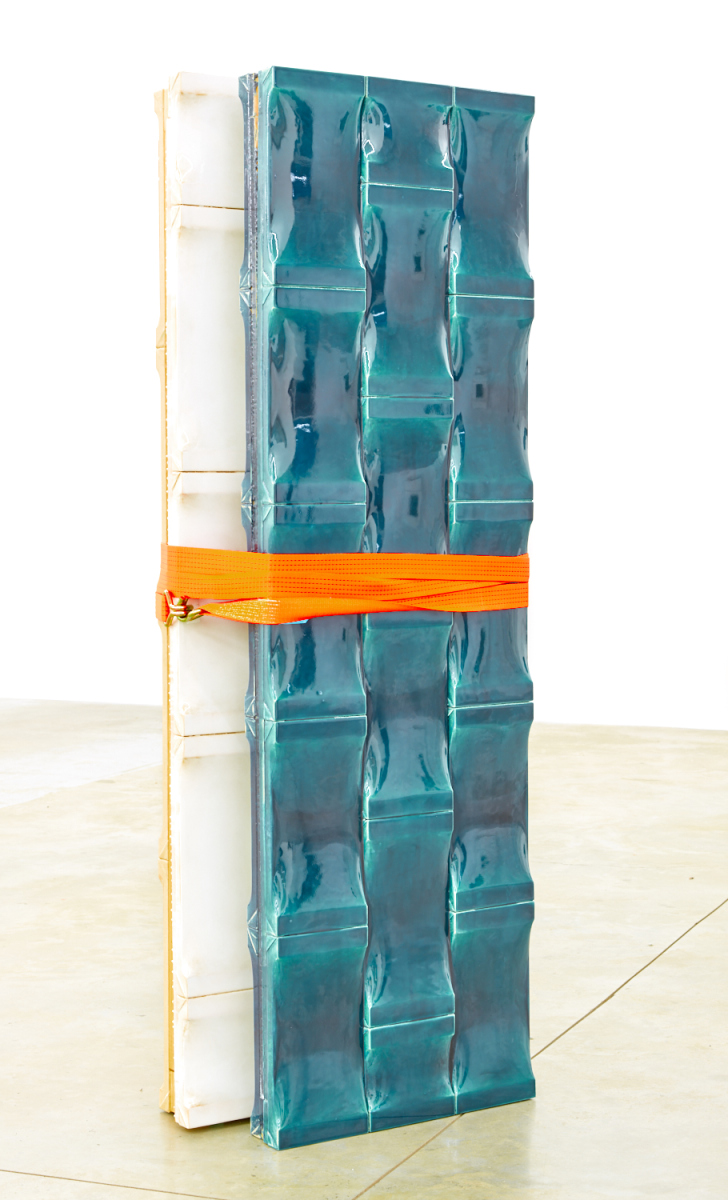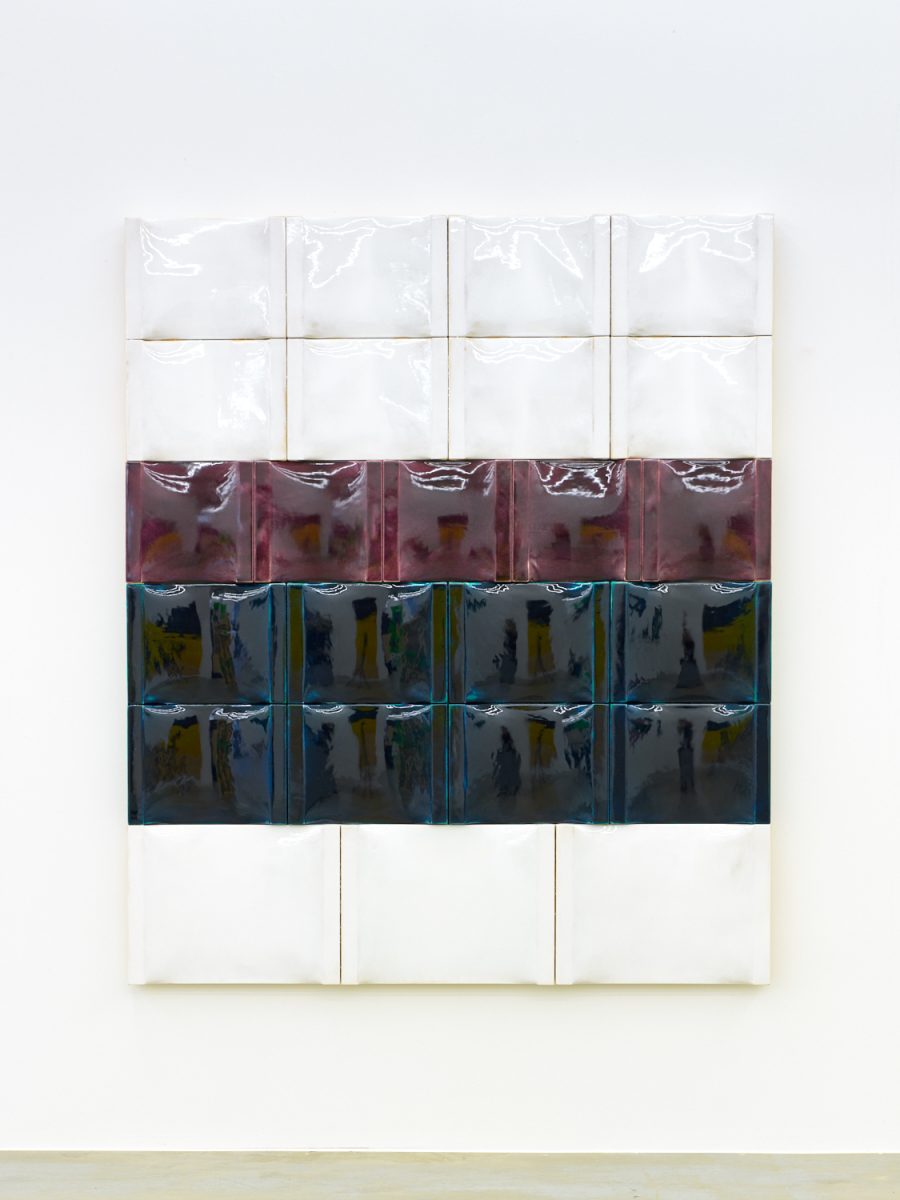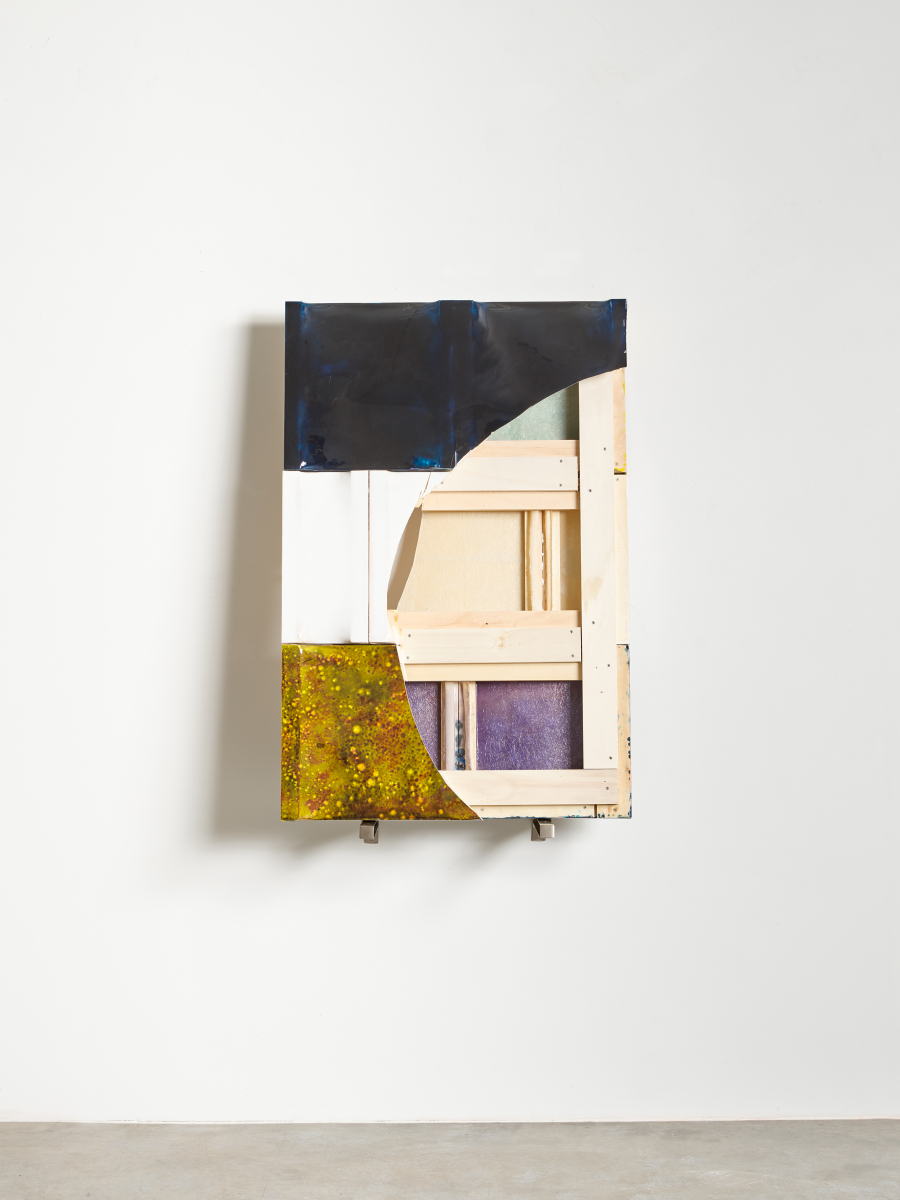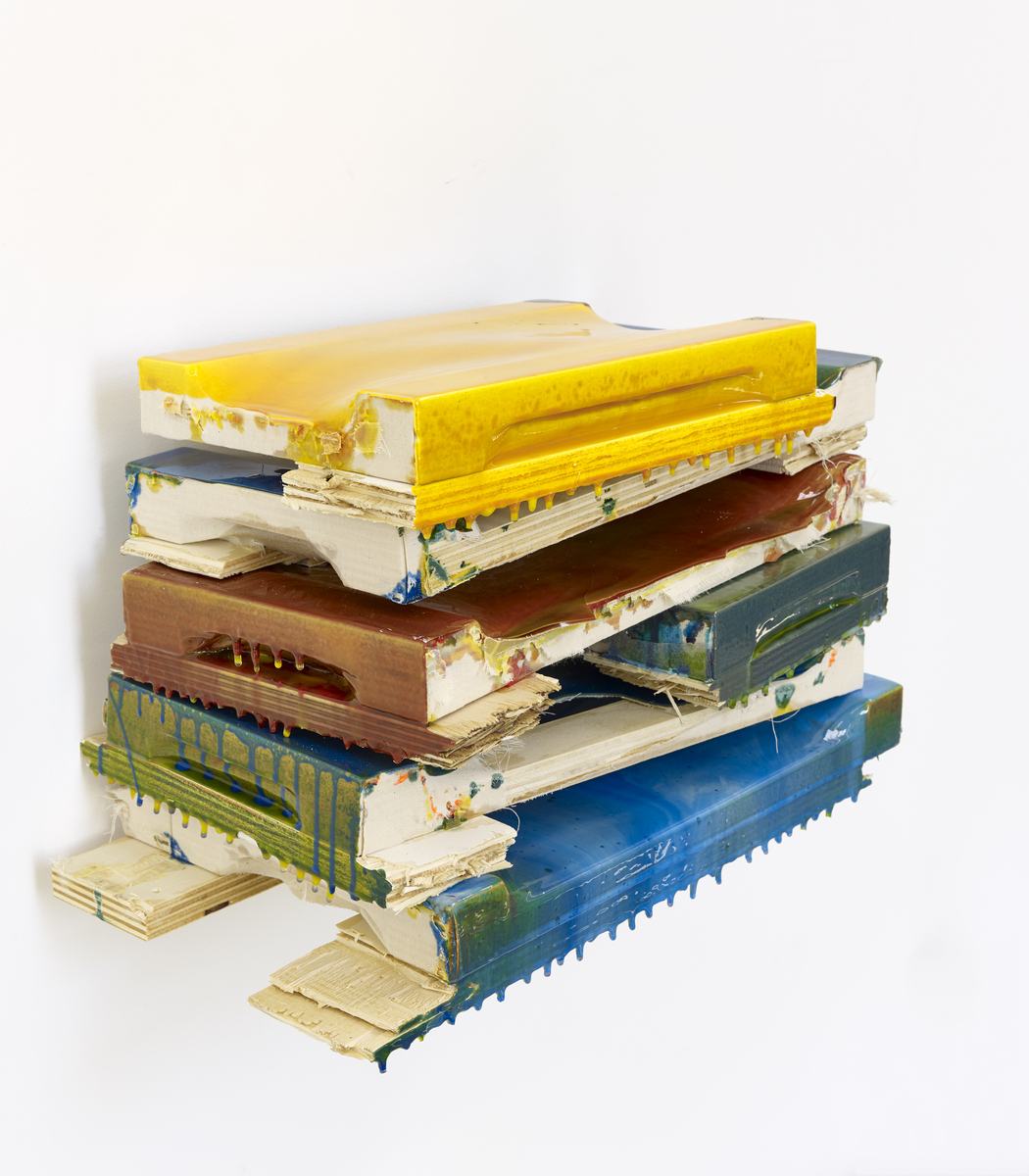Roland Quetsch

Roland Quetsch
Born in 1979, in Luxembourg.
Lives and works, in Luxembourg.
Education
BFA Marc Bloch University of Strasbourg, France
Presentation
In much of Quetsch’s work, the choice of materials, the means of manipulating them, and the spaces created by them are considered their content. The advantage of remaining within a traditional form such as painting is that it affords the ability to address the tenor, stresses and disarray of contemporary life from the vantage point of meditative remove, accompanied by sensate dramatics. This creates a psychic charge that seems to draw on the past as it fully addresses the present.
Joe Fyfe, Roland Quetsch, Editions Ceysson, 2018 - extract
Roland Quetsch is first and foremost (and was, chronologically) a manufacturer. The treatment of the picture carriers/ visual tools/ supports of his paintings makes them similar to structured canvases from the outset, thus to real pictorial objects with their game of reliefs, the opposition of horizontal bands given a priori by the canvas, their regularity and the almost insurmountable, as well in number as in fulguration, interweaving or even trellis, that overlays them. As a result, numerous openings, all highly animated, and a multiplicity of spaces, overlapping with varying degrees of depth, are created, giving the painting its life and topography. The quality of the art of Roland Quetsch, failing to speak of a miracle, is that these fragments, these broken, torn spaces, eventually lead to/ end in unity; the centrifugal movements do not alter however, quite on the contrary, they underline a substantial concentration. It is high time then to mention the other aspect of this art: Roland Quetsch is at least as much a colorist, which he demonstrates by the same ease with contrast as with monochromatic colour schemes. There is definitely something in this art/ painting which conveys delight/ rapture/ ravishment; yet, at the same time, it is always marked by the same level of rigor.
Text by Lucien Kayser 2011 (Exhibition Luxembourg - Salzbourg)
There is a defiance present in the abstract paintings of Roland Quetsch. I use this term—defined as disposition to resist, willingness to contend or fight—because while it is clear that he accepts certain restrictions that accompany the boundaries of serious abstract painting—the rectangle, paint on a support, non-referentiality, ambiguous color—Quetsch appears determined to make his mark by contorting these conventions into less recognizably familiar forms.
As one discovers in the following interview, he has taken up this challenge through an exuberant interrogation of the most advanced artists of previous generations, citing the meteoric post-minimalist German Blinky Palermo and bedrock American late modernist Frank Stella, among others.
During an exhibition in Saint-Etienne, France, at the Ceysson & Bénétière gallery, one saw that Quetsch had taken advantage of his recent work’s resemblance to upended generic furniture by exposing the chassis, flipping the outside surface to reveal the backing, in some cases, and in others, permitting light to shine through the semi-transparent support. The works were installed in such a way that they were suspended on the edges of the gallery walls, exposing their fronts and backs, problematizing any direct readings. These physical realignments are evidence of his ongoing interest in formalist structures and procedures. He does not stop there, but moves unexpectedly towards the baroque—a style whose name originated in the description of an imperfect pearl—arriving at a rough-hewn opulence.
If there is a tradition in abstraction that aligns itself with Quetsch, I would say he has affinities with areas opened up by Hans Hartung, who anticipated contemporary concerns with disruptive light reflections and with texture. Hartung once said that his painting has “a constant but very complex relationship with what we have come to term exterior reality.” Similarly, Quetsch’s works reveal another characteristic of recent abstraction: a de-emphasis of first-person authorship and a foregrounding of the industrial aspect of materials and techniques, as well as a cross-pollination of intimate space and problematized viewing and sequencing, some of which is derived from digital photography and architecture.
Quetsch’s interface with architecture came from an earlier period where he built some tabletop models of houses, achieving a unity of “just surfaces” as he described them, in one case a series of models that were reduced footprints of the flooring of tract houses. One sees here the origins of the later work, where Quetsch invented a way to reconstruct a surface using his shaped canvas modules. The modules (which he began utilizing in 2003) to his credit, do not present a stylistic continuity but continue to afford new opportunities for structural metaphor: barriers, fences, windows, surfaces of automobiles and ceramics, and even candy bars. One is provided with an index of proximities to everyday objects, while simultaneously engaging in contemporary dream-state projection, in other words, the confrontation of the quotidian with the inexplicable.
In much of Quetsch’s work, the choice of materials, the means of manipulating them, and the spaces created by them are considered their content. The advantage of remaining within a traditional form such as painting is that it affords the ability to address the tenor, stresses and disarray of contemporary life from the vantage point of meditative remove, accompanied by sensate dramatics. This creates a psychic charge that seems to draw on the past as it fully addresses the present.
- Joe Fyfe
Roland Quetsch tests the possibilities and potential limitations of painting in his congruent body of work. Unlike pure or radical abstraction, this inquiry considers both surface and support on equal terms. Manipulating and building his own supports, as he has done since 2000, Quetsch produces works that resist a purely superficial contemplation and test the eye and intellect of the beholder. The principle of fragmentation - of the canvas and sometimes also the fields of colour - creates a subtle play of surface and space in works poised between painting and sculpture.
The works are often produced in series. Within a series, the individual units function as distinct and independent works which are nevertheless formally coherent and interconnected. The importance of the whole as opposed to the individual part is particularly evident in the series p.o.s.b. ("part of something big", 2009-2011) and f.o.s.b. ("fragment of something big", 2012), not least on account of the titles. The group p.o.s.b. consists of a total of 75 works covering the entire colour spectrum, beginning with white and moving gradually through to black. Rows of small canvases, built and stretched by hand, create a rhythmic surface structure. The artist applies the colours onto this construction in multiple layers and divides them into geometric fields, sometimes defining and demarcating them with tape as he works. But the boundaries are porous; the fields of colour encroach on one another, and splashes and drips of paint across the surface imbue the whole with a spontaneous, untamed quality.
Both the fragmented base and the riven, restless surface direct the gaze in ever new directions. The eyes have to continuously readjust to new fields and the underlying layer of colour shimmering through. It seems almost impossible to grasp the composition as a whole and the entire conjunction of constructed support and deconstructed surface. The series f.o.s.b. is founded on a similar principle of construction and deconstruction of the surface and the painting. In Nos. 1 to 10 the entire surface is painted, while from No. 11 onwards there are some vacant, white places, resulting in more tranquil compositions.
This simultaneous dismantling and reconstruction of the painting in the eye of the beholder derives from digital imaging. A digital image, though it appears to form a unified whole, is in fact divided into millions of pixels. Only through the combination of all the pixels does the whole acquire meaning. For Roland Quetsch, too, artistic creation is part of a greater context: "My paintings are fragments, parts of something bigger, parts of painting but also a part of life, of the world." On one hand, Quetsch's oeuvre is a coherent and congruent body of work that consistently focuses on painting and its analysis. But his work is also closely connected with life itself. The diversity and tremendous potential of his painting clearly become apparent in the context of other works and series, of different methods and ways of working with the canvas and the paint. With the passing of time and ongoing artistic production, then, the work as a fragment of something bigger will acquire an even more distinct and deeper meaning.
Quetsch's works are often conceived in groups, and they are all based on the principle of the construction and fragmentation of the canvas and support. And yet they never simply repeat motifs or forms as was the case, for instance, with some of the exponents of the artist group Supports/Surfaces. Quetsch's creative output is indeed heterogeneous, there are many different facets to his work. Early on, and at times also later in his career, he also engaged in figurative painting. One example is the 2008 work Ohne Titel (Ich bin tot, der Hof ging an den ältesten Bruder, wasch noch deine Zähne und dann geh auch heim, A+) (Untitled [I am dead, the estate/farm went to the eldest brother, clean your teeth and then go home too, A+]). It consists of a large, hand-built and stretched canvas placed in the exhibition space and portraying a horse and rider in white on black. The depiction of the man, no longer young, on a lean horse is a reference to Albrecht Dürer's Four Horsemen of the Apocalypse and speaks of death and those who try in vain to flee. It is worthy of note that the artist also draws on other techniques and mediums to express his artistic ideas. In the performances, videos and often ironic works of the artistic duo toitoi, the concept and the procedure are the central concerns.
His abstract works are likewise wide-ranging and complex. This is particularly apparent in the new series Ǝ (2014) and l (2014). The large-scale works of Ǝ recall the horizontal or vertical form of the letter "E", with each of the specially constructed canvases containing two elongated openings or holes in the middle. For each of these works, Roland Quetsch selects four colours, having first explored their combination and effect in small works on paper, which he calls colortests. The use of a very wide spectrum of colours lends each work a highly distinctive appearance. The open, empty gaps correspond to the white areas in the group f.o.s.b. They are places of repose for the gaze and allow the viewer a moment of pause. Opening out like windows onto the wall behind, the underlying plane, they extend the pictorial space by another dimension that lies outside the primary picture plane.
Each work in the series l consists of a combination of two surfaces that initially appear monochromatic. Here, too, each work is made up of rows of smaller canvases. In some works, the paint is matt. Others are finished with epoxy resin, creating a reflective surface. As in the series Ǝ, these pared-down works derive their strength chiefly from the combination of colours, built up in multiple levels and layers of paint. Green and blue shimmer through the yellow, pink and red through the deep violet blue. The beholder pauses to reflect and is compelled to concentrate on the surface in order to make out the finest of nuances.
Both groups, Ǝ and l, have titles that can be described but not clearly defined. "l" can stand for the letters "i" or "l". It is, however, also a simple vertical line and inevitably calls to mind artists like Piet Mondrian, for whom the vertical line represented bipedal man. But the titles are visual as well as verbal. They draw attention to the perception of the viewer. Artist groups like BMPT and Supports/Surfaces regarded artistic creation as being entirely independent of any personal context. They wanted a painting that defied precise definition and connotation. The act of contemplation alone was important, not any form of interpretation. Like the works of Daniel Buren, Olivier Mosset, Michel Parmentier and Niele Toroni, Quetsch's work calls for a demystification of art. And yet some of the works of the series l do carry a subtitle evoking a concrete image: l 2 (A pig in the closet) or l 6 (Asphalt junkies). The first consists of one black and one rose-coloured surface; the second, one black and one grey. With humour and perhaps a hint of irony, the subtitles suggest a possible specific association and open the work up to multiple interpretations.
Above all, one is struck by the irresistible presence of these works, a physicality that derives not only from their sheer scale, but primarily also from the relief texture of the canvases. Artists like Paul Klee who primed and textured their works with gypsum or gauze were aware of the effect of the prepared support. At the end of the 1950s, Günther Uecker covered the surface of his canvases with nails so that their relief and appearance would shift with the movement of the viewer; similarly, Enrico Castellani created rhythmic textures by manipulating his canvases with a nailing machine. Light and shadow are not created by the meticulous gradation of colour on a two-dimensional plane or by external illumination, but are firmly anchored in the substance itself. Roland Quetsch's hand-built and assembled canvases play a similar role. As well as lending the surface a rhythmical quality, the underlying structure also invites an exploration of the painting and its effect on the viewer in changing lighting conditions. The joins cast shadows; pools of light form on the upper edges of the underlying wooden frames. The effect of this structure produced by the individual supports is particularly evident in the series I. With their epoxy resin finish, the horizontal rows formed by the small canvases assume the appearance of reflecting building blocks or lattice window panes. The multiplication of the reflection deliberately directs the gaze to the underlying and fragmented construction.
Roland Quetsch's technique attests to his keen interest in building and construction and lends his works a sculptural quality. Almost all of the works in the series l consist of ten horizontal rows each composed of two smaller canvases measuring 20 x 25 cm and 20 x 50 cm. This calls to mind architectural structures and, specifically, brick walls. It is interesting to note in this connection one of Roland Quetsch's earlier works. His particular concern throughout 2004 and 2005 was housing in Luxemburg and the attendant social problems (such as exorbitant rents and prices). He recreated a residential building from the city of Esch-sur-Alzette on a scale of 1:10 (Untitled [House 1, 1:10, B+, 2004]). In collaboration with the architect Thierry Cruchten, he conceived a system of modules to build studios for artists (Untitled [House 2, construction in progress, A+B], 2005). Nor must his works necessarily hang on the wall - some rest on the floor and themselves assume the function of walls, as in Ohne Titel (Ich bin tot, der Hof ging an den ältesten Bruder, wasch noch deine Zähne und dann geh auch heim, A+) (Untitled [I am dead, the estate/farm went to the eldest brother, clean your teeth and then go home too, A+]). Thus the painting is not merely an object of contemplation but has many different applications as an integral part of life itself. Its relationship to three-dimensional space is underscored when the works are not hung conventionally on the wall.
If the works from the group Ǝ are reminiscent of windows, those of the series I may be seen as walls or lattice windows with concave panes. Artists like Ellsworth Kelly have also been inspired by architecture and its structures. Kelly was chiefly interested in the physical structure of the city of Paris and specifically in windows. In the spare, abstract works of the Windows series, he analyses window mullions and their representation in stark contrast against the light. Similarly, rather than being interpretations of what he sees, Roland Quetsch's works are constructions. A detail of an old wall, the play of light and shadow on a uniform surface, or the juxtaposition of an outer wall and the sky - all of these are possible inspirations for Quetsch's compositions. While Kelly worked with sharp borders and eliminated in his painting all traces of personal style, Quetsch's lines and boundaries are more permeable. Streaks and fissures disturb the surface. In l 3 the canvas is pushed inwards and perforated in places; the top half of the right-hand panel of l 14 (Kabow) appears to be buckled or bent. The constructed paintings thus bespeak a real-life environment that accepts irregularities and which it is possible to disrupt.
And yet the use of epoxy resin and the reflective surface it creates lend the works an additional, almost unreal dimension. The concave form of the small assembled canvases underscores this mirror effect, reflecting the viewers and their surroundings in each of the surfaces. The reflection varies in strength according to the colour and light. Michel Foucault described the mirror image as a deception, because it reproduced an object, or person, in a different space to the one in which it was actually located: "The mirror is a utopia after all, since it is a placeless place. In the mirror I see myself where I am not, in an unreal space that opens up virtually behind the surface; I am over there where I am not, a kind of shadow that gives me my own visibility, that enables me to look at myself there where I am absent-a mirror utopia. " The mirror and the reflective surface make it possible to see oneself in a location or space in which it is impossible to physically exist at the same time. The space of the mirror is a virtual space. At the same time, the reflective surface extends the gaze, allowing us to contemplate our surroundings from a different perspective.
At the heart of the series I, then, lies not only the principle of fragmentation but also that of multiplication. The inclusion of the viewer and his or her surroundings implies a social dimension and follows from Quetsch's interest in the social structure of the urban environment. The elusive reflections in the boldly coloured panels evoke the abstract tradition. Neither representation nor interpretation, the reflected image is a presence, a spontaneous manifestation on the surface of the canvas, that shifts constantly with the movement of the viewer. With the use of epoxy resin and the reflective surface, Roland Quetsch tests the limits of painting on yet another level. As well as the customised construction of the canvases and the application of the paint in multiple layers, the mirror finish is another means of projecting colour into the work. Operating on many different levels, the painting invites viewers to immerse themselves in it and, like the artist himself, to engage with the genre and reflect on its relationship to people and their everyday lives.
- Florence Thurmes
Fragmentation is a key concept for the new series of black and white paintings presented by Roland Quetsch at the Dudelange Art Centre. In a continuation of the p.o.s.b. (part of something big) set, these new pictorial objects stand out for their rejection of stereotypes of perspective. These paintings are a constant challenge for the eye, which seeks to accommodate these oppositions of cuts and surfaces, but is unable to do so.
Like shrapnel of dislocated geometric models, the iconography of f.o.s.b. (fragments of something big) breaks into our world of ordered visual organisations. These black and white grid layouts that simulate space the better subsequently to explode it into pieces are the result of a thorough conceptual work. A work of permanent construction and deconstruction of space, coupled with a physical presence of pictorial material that reinforces this impression of impossible architecture on which part of this work seems to rest. Roland Quetsch reconstitutes his complex compositions from details of ordered visual systems. But as soon as he reframes, cuts and repositions his surfaces and grids, this primary order disappears and sinks into a kind of visual madness. Underlying everything, there is always the construction of modules that give body to the canvas. There is a constant denial of the simple flat surface. The support of these paintings is submitted to wholly specific laws of physics. It is the result of a tension caused by an interplay of forces developing from the making of the support itself.
There is also a physical presence thanks to the massive appearance of these basic, brick-like elements, which provide support and whose actual weight has its counterpart in the painting itself. This construction of the pictorial supports makes possible their systematic alternation by their very configuration. This alternation also helps to add dynamism to the application of colour itself. The differences alone in the shades of white in this series illustrate the potential of the possible contrasts and the optical vibration they introduce into these empirical compositions. The black and white matter is changeable, with the different surface treatments not simply giving binary contrasts, but rather a multitude of passages and contrasts between matt and shiny surfaces, between more or less pure white renditions, and deep blacks alternating with shimmering dark tones.
In this painting, many things might be predictable, but in reality Roland Quetsch succeeds in creating a permanent discrepancy to escape all determinism, any rule that would lead to a contemporary academicism. In this sense, Roland Quetsch is a painter who stands out, and who builds his own and individual points of reference. The very development of his paintings becomes the concept.
- Christian Mosar in the exhibition catalogue at the Centre d'art Nei Liicht
Roland Quetsch, Paris
February 17 - March 19, 2022
Roland Quetsch , Wandhaff
December 14, 2019 - February 15, 2020
Roland Quetsch, Saint-Etienne
March 01 - April 21, 2018
ROLAND QUETSCH, Wandhaff
May 25 - May 29, 2016
Roland Quetsch, Paris
May 30 - July 25, 2015
Roland Quetsch, Luxembourg
February 08 - April 20, 2014
Roland Quetsch, Saint-Etienne
January 10 - April 10, 2013
Roland Quetsch, Luxembourg
March 08 - May 05, 2012
Group shows at Ceysson Gallery
10 YEARS in Luxembourg, Wandhaff
June 02 - August 04, 2018
“The lines of life are various, like roads and the contours of the mountains…”, Wandhaff
September 10 - October 29, 2016
La Ligne Passée, Luxembourg
June 30 - September 16, 2012
Solo shows
2018
Paintings (we all share the same sun), Ceysson & Bénétière, Saint-Étienne, France
2016
Interlude O.P. 1 , Galerie Bernard Ceysson, Wandhaff, Luxembourg
2015
Fragmented Mixtape, Galerie Bernard Ceysson, Paris, France
Galerie Bernard Ceysson, Paris, France
2014
I, Saarländisches Künstlerhaus e.V. Saarbrücken, Germany
E, Galerie Bernard Ceysson, Luxembourg
2013
Roland Quetsch (Out of the Dark), Galerie Schlassgoart, Pavillon du Centenaire, Esch-sur-Alzette, Luxembourg
F.O.S.B N°15 - 21, Galerie Bernard Ceysson, Saint-Étienne, France
2012
Oeuvres récentes, Galerie Bernard Ceysson, Luxembourg, Luxembourg
2005
S.t. (maison 2, chantier ouvert), curated by Enrico Lunghi, KIOSK, AICA, Luxembourg
Group shows
2018
Art2cure New York, Ronald Feldman Gallery, New York, USA
2016
Diverses sont les lignes de la vie..., Galerie Bernard Ceysson, Wandhaff, Luxembourg
Non figuratif, un regain d'interêt ?, Abbaye St André - Centre d'art contemporain, Meymac, France
Art2cure Luxembourg, Fondation indépendance, BIL, Luxembourg, Luxembourg
The present is yours, the future is mine Cercle cité, Luxembourg, Luxembourg
2012
Making of, Casino Luxembourg - Forum d'art contemporain, Luxembourg, Luxembourg
La ligne passé, Galerie Bernard Ceysson, Luxembourg, Luxembourg
Oeuvres récentes, Galerie Dominique Lang / Galerie Nei Liischt, Dudelange, Luxembourg
2011
A vol d'artiste: Salzburg - Luxemburg, Traklhaus, Salzburg, Austria
Nur die Guten kommen in den Garten, Konschthaus beim Engel, Luxembourg
A vol d'artiste: Salzburg - Luxemburg, BGL PNB Paribas, Luxembourg, Luxembourg
2009
Kunst-en-Zwalm, Zwalm, Belgium
2008
Time Square, Galerie Beaumontpublic, Luxembourg, Luxembourg
Festival arbres et lumières, Luxembourg, Luxembourg
Elo: Inner Exile -Outer Limits, MUDAM, Luxembourg, Luxembourg
2007
Agorafolly outside, Place du Finistère, Bruxelles, Belgium
Agorafolly inside, La Centrale électrique, Bruxelles, Belgium
Affinità-Diversità, Palazzo Albrizzi, Venise, Italy
Not Closed, Galerie Beaumontpublic, Luxembourg, Luxembourg
Multiplex en residence, LX5 Homebase, Luxembourg, Luxembourg
Ziel 1 = Kunst = Ziel 1, Nordico-Museum, Linz, Austria
Roundabout - Refreshing Art, Rotonde 2, Luxembourg
"Roland Quetsch I", Saarländisches Künstlerhaus Saarbrücken e.V., 20.11.2014 - 04.01.2015
2014
"Roland Quetsch Ǝ", Bernard Ceysson Gallery Luxembourg, 08.02.2014 - 20.04.2014
2013
"Roland Quetsch (Out of the dark) 16 paintings", catalogue published in the context of the exhibition "Out of the dark" at the Galerie Schlassgoart, Pavillon du Centenaire, Esch-sur-Alzette, Luxemburg, 22.03.2013 - 19.03.2013
2012
"Roland Quetsch, Billy the Kid", catalogue published in the context of the exhibition "Roland Quetsch - Billy the Kid", exhibition related to the project "Making of" at the Casino Luxemburg - Contemporary Art Forum, Luxemburg, 16.09.2012 - 16.12.2012
"Roland Quetsch: Recent works", catalogue published in the context of the exhibition "Recent Works" at the art galleries Dominique Lang et Nei Liicht in Dudelange, Luxemburg, 2012
2011
"Roland Quetsch - A vol d'artiste : Salzburg - Luxemburg", Ed. Galerie im Traklhaus, 2011
2009
Kunst & Zwalm 2009, VZM Boem, 2009
2008
"Borderline", published by Borderline, Luxemburg, 2007/2008
"ELO", Mudam Luxemburg, 2008
"Virdrun", Mudam Luxemburg, 2008
"Salon 2008", Cercle Artistique de Luxemburg, 2008
Rendez-vous, 10/2008, 12/2008
Flydoscope, October 2008
2007
"Visites d'Ateliers no. 4", mediart, Luxemburg, 2007
Agorafolly outside inside, europalia.europa and La Centrale électrique - European -Center for Contemporary art, 2007
"Roundabout - Refreshing Art", Rotonde 2, Luxemburg-Bonnevoie, 2007
2006
"L'art au Luxembourg, De la renaissance au début du XXI siècle", Fonds Mercator - Editions Schortgen, 2006
"My Home is My Castle", Galerie l'Indépendance, Parc Heintz, Dexia-BIL, Luxemburg, 2006
"Ziel 1 = Kunst = Ziel 1", Workshops 2004/2005/2006, 2006
L'ESSENTIEL - Luxemburger zerschneidet seine eigenen Werke - 2020
L'ESSENTIEL - Marlene Brey
February 06, 2020
Voir le fichierD'LETZEBUERGER LAND - Brelan de peinture - 2020
D'LETZEBUERGER LAND - Lucien Kayser
January 17, 2020
Voir le fichierRTL - Exposition Roland Quetsch à la Galerie Ceysson - 2019
RTL - Jenny Fischbach
December 31, 2019
Voir le fichierCHRONICLE - La Galerie Ceysson & Bénétière conclut l'année avec trois expositions - 2019
CHRONICLE - JCA
November 29, 2019
Voir le fichierL'ESSOR LOIRE - Roland Quetsch chez Ceysson - 2018
L'ESSOR LOIRE - Daniel Brignon
March 24, 2018
Voir le fichierLuxembourg Art Week
November 09, 2018
